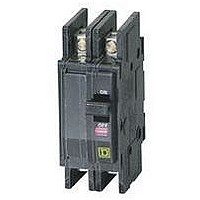QOU2100 SQUARE D, QOU2100 Datasheet - Page 19

QOU2100
Manufacturer Part Number
QOU2100
Description
CIRCUIT BREAKER, THERMAL MAG, 2P, 100A
Manufacturer
SQUARE D
Series
QOUr
Datasheet
1.QOU1100.pdf
(32 pages)
Specifications of QOU2100
Actuator Style
Toggle
No. Of Poles
2
Current Rating
100A
Voltage Rating Vdc
48V
Voltage Rating Vac
240V
Mounting Type
DIN Rail
Lead Free Status / RoHS Status
Contains lead / RoHS non-compliant
QOU Miniature Circuit Breakers and Switches
Circuit Breaker Tripping Characteristics (Trip Curves)
CIRCUIT BREAKER TRIPPING CHARACTERISTICS (TRIP CURVES)
The tripping characteristics of thermal-magnetic circuit breakers are represented by a characteristic
tripping curve that plots tripping time versus current level. See page 20. The curve shows the amount
of time required for a circuit breaker to trip for overcurrent through the entire tripping range of the circuit
breaker. Manufacturing tolerances result in a curve that is a band bound by minimum and maximum
values of total clearing time. Total clearing time is the sum of the sensing time, unlatching time,
mechanical operating time, and arcing time of the circuit breaker. For currents in excess of 135 percent
of the circuit breaker rating at ambient temperature (40°C/104°F), the circuit breaker will automatically
open the circuit within limits specified by the band.
Thermal Tripping Characteristics
The upper left portion of the characteristic tripping curve displays the thermal response of the circuit
breaker. On overcurrent levels, up to the instantaneous tripping level, thermal tripping occurs when the
bimetal in the circuit breaker responds to the heat associated with the overcurrent. The bimetal
deflects, unlatching the mechanism and mechanically causing the circuit breaker to trip and open the
circuit. The larger the overcurrent, the faster the circuit breaker operates to open the circuit (inverse
time).
Magnetic (Instantaneous) Tripping Characteristics
The lower right portion of the characteristic tripping curve displays the magnetic (instantaneous)
tripping response of the circuit breaker. This takes place when overcurrents of sufficient magnitude
operate the magnetic tripping mechanism. Magnetic tripping occurs with no intentional delay.
19
09/2005
© 2005 Schneider Electric All Rights Reserved














